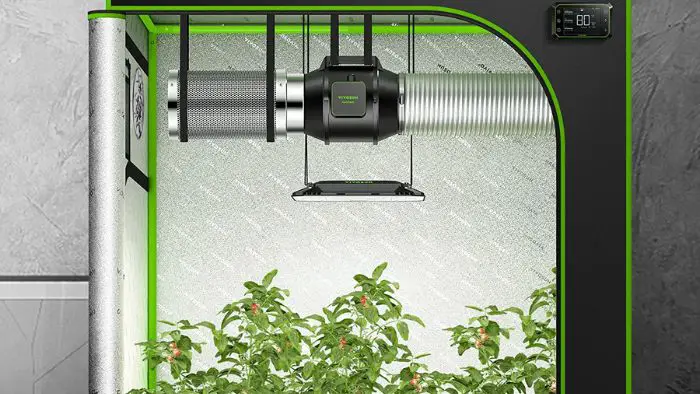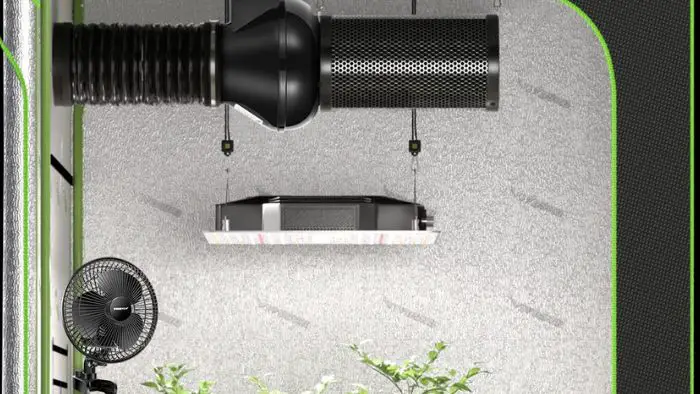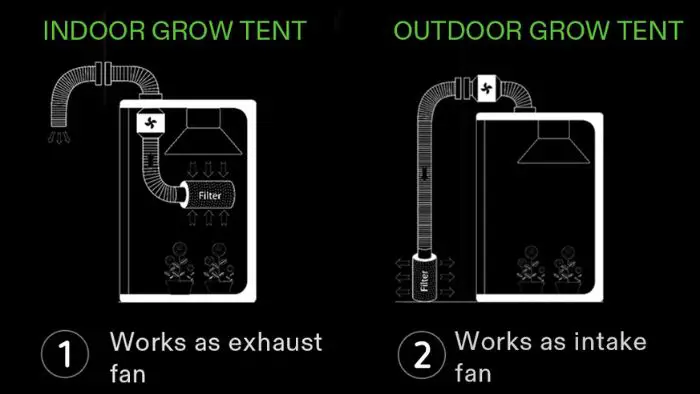Last Updated on March 5, 2023
So how often do run an exhaust fan in grow tent? If you are growing plants in an indoor environment, you need to use an exhaust fan to make it ideal for your plant. It is therefore important that you know how often to run an exhaust fan in grow tent, to get the best efficiency from both your exhaust fan and grow tent.
In a perfectly designed system, an extracted fan should replace the air in your grow tent at least every three to five minutes. To be able to achieve this efficiency, you have to choose the right size fan to get the job done.
Grow tent ventilation can actually be very simple, as long as you understand the basics. So let us get right into it.
How Important is an Exhaust Fan in a Grow Tent?
So why do you need a fan in your to-grow tent? Well, there are several reasons:
-
For removing excess heat
In an indoor growing environment, there may not be a lot of natural light that enters. In this case, you will need to use grow lights. These grow lights however emit heat which may increase the temperature of the grow tent. This may not seem like much, but a change in a few degrees of temperature can mean the difference between the success and failure of a crop.
Of course, certain grow lights will emit more light than others. This is often not a problem with LED lights, but all of them produce enough heat to necessitate ventilation. Exhaust fans are necessary to help remove all the excess heat and keep your plants happy.
-
Humidity control
Plants in a grow tent emit vapor throughout the day which will increase the humidity of the tent. If the humidity is left uncontrolled, it will result in poor growing conditions in the room, which will often result in the development of pests and diseases. An extractor fan will help to suck out all the extra moisture, helping maintain humidity at a minimum.
-
CO2 control
Because a grow tent is sealed, the level of CO2 will gradually decrease, limiting the growth of your plants. Ventilation from an exhaust fan will bring fresh CO2 from outside and boost plant growth and productivity.
If grow tent setup is sealed, this means that the level of CO2 in the room gradually decreases, limiting your plants’ growth. Ventilation brings in the fresh air and fresh CO2 from outside and removes the old air from your grow room, boosting growth and yields.
-
Photosynthesis
Plants need CO2 for photosynthesis. In a grow tent without adequate ventilation, the CO2 will become stale. This will become destructive to your plants if it is not solved with the addition and use of an exhaust fan.
How Often to Run Exhaust Fan in Grow Tent?
Different grow tents require different amounts of ventilation. To know how often to run an exhaust fan in grow tent, you will need to first measure the volume of the grow tent in cubic feet.
The running unit of an exhaust fan is measured in CFM, short for cubic feet per minute. This is an indication of the total volume of air that should be exchanged in the grow tent. If you are unsure how to do this yourself, certain calculators such as this one will help you work out these values.
Ideally, your exhaust fan should replace the total volume of the air in your grow tent every 3 minutes. Let’s suppose, for example, you have a grow tent with a CFM of 720. You would divide this number by 3;
- 720/3 = 240
If you had an exhaust fan with a capacity of 240 CFM, you would need to run it continually to replace the air in your 720 CFM grow tent. But if you have a full capacity one (i.e. 720 CFM), you would only run it once every three minutes.
Should I Turn My Fan Off at Night?
You should always keep your extractor fans running as long as the lights are on in your grow tent. Colder nights may not need ventilation but during summer, you may put them on a schedule. You can also use sensors to detect if any parameters are off so you can know when to turn the fan on.
Does a Sealed Grow Room Need Fresh Air?
A sealed grow room needs excellent ventilation to cycle out the cold air and bring fresh air in. Otherwise, your plants will die.
The total volume of the air needs to be replaced every three to five minutes. Make sure you get the right size fan to get the job done.
How Do You Set Up an Exhaust Fan in a Grow Tent?
The best time to install an exhaust fan in a grow tent is during the setup stage. This is so that you will not have to work around existing plants in your system, which may potentially kill them.
Calculate the total volume of your grow tent to ensure that you get the best fan that will be able to efficiently ventilate.
Once you have the fan specifications, choose the model and make that you want, in the price range you can afford. You can also look at reviews to help you decide on the best model and make sure you get the best fan for your money. Also, check of the fan comes with a filter, or if you need to purchase one separately.
If you are mechanically inclined, you can install the fan yourself; otherwise, get a professional to help you install it.
How Often Should Air Be Exchanged in Grow Room?
You may be wondering how often the air should be exchanged when in the grow room. The truth is, it depends on the size of the grow tent. However, the rule of thumb is that the air should be exchanged in your grow tent every 3-5 minutes or so, for best results.
Grow Room Exhaust System Setup
To set up an exhaust system in your grow room, you’ll need to follow a method to ensure you get the best results. Let’s take a closer look.
- Choose your equipment. Depending on what you’re growing, you’ll need certain-sized equipment. The first thing you’ll need is your exhaust fan and intake fan, which you should choose accordingly to the size of your room. Ideally, you should get fans of the same size, or a slightly smaller intake fan. You’ll also need a controller, circulation fan, ducting, and carbon filter.
- Begin installing. You’ll need to install the exhaust fan first, along with the carbon filter. Decide where you think is best, this can be anywhere inside or outside of the tent; assuming it’s within reached. Ideally, it should be inside. Attach with tape and ducting and place the ducting outside.
- Install further. Now it’s time to install your intake fan. This should be opposite your exhaust fan. Having them opposite one another will ensure you get the best results from your to grow tent. Just like before, secure with ducting and tape.
- Circulation fan. Now it’s time to add at least one circulation fan; however, I would recommend using two for slightly larger tents. This particular fan should be kept running at all times; irrespective of whether the lights are on or not.
- Set up the controller. Check everything you’ve already set up is working adequately, then set up the controller to match the cycle you’re following in your grow tent.
Do I Need to Vent My Grow Tent Outside?
The truth is, you can vent wherever you want; inside or outside. However, most people like to vent their grow tent outside to ensure no damage is caused to their houses. However, it all depends on what you’re growing. For example, for something like cannabis, you should absolutely try to exhaust it outside. Try to make a decision based on what you’re growing and what you think is best for your plants.
How Long to Leave Fan on Plants?
You may be wondering how long to leave your fan on your plants. And in all honesty, it all depends on which fan you’re talking about. For example, your circulation fan should be kept on at all times; regardless of whether your grow lights are on. However, for your inline and exhaust, you can reduce the speed after around 30 minutes of your grow lights being off and then reduce gradually before turning off completely after around three hours,
However, when your plants are still seedlings, you may decide to keep them on 24 hours a day for best results, as this will ensure they thrive once they’re older. It all depends on what you’re growing.
Conclusion: How Often to Run Exhaust Fan in Grow Tent
We hope this article has provided you with the information you needed to make the best decision with regards to getting the best exhaust fan for your grow tent and to know how often to run it so you get the best efficiency and benefits for your plants.
If you enjoyed reading this article or found it useful, feel free to share it with your family and friends.

An aquaculture specialist and freelance writer. Passionate about anything sustainable living, such as growing your own food, and if you can do it in conjunction with fish farming, even better! I currently work as an aquaculture researcher where I can expand and share my knowledge and skills on aquaculture, crop farming and adding value to wastewater by using it to grow food products. I enjoy reading and learning as much as possible, and writing is another avenue for me to share the knowledge I gain with others. I want my writing to inspire people to try their hand at gardening, whether indoors or outdoors. You can even start by keeping a few houseplants indoors to help you gain a bit of confidence if you need to.





